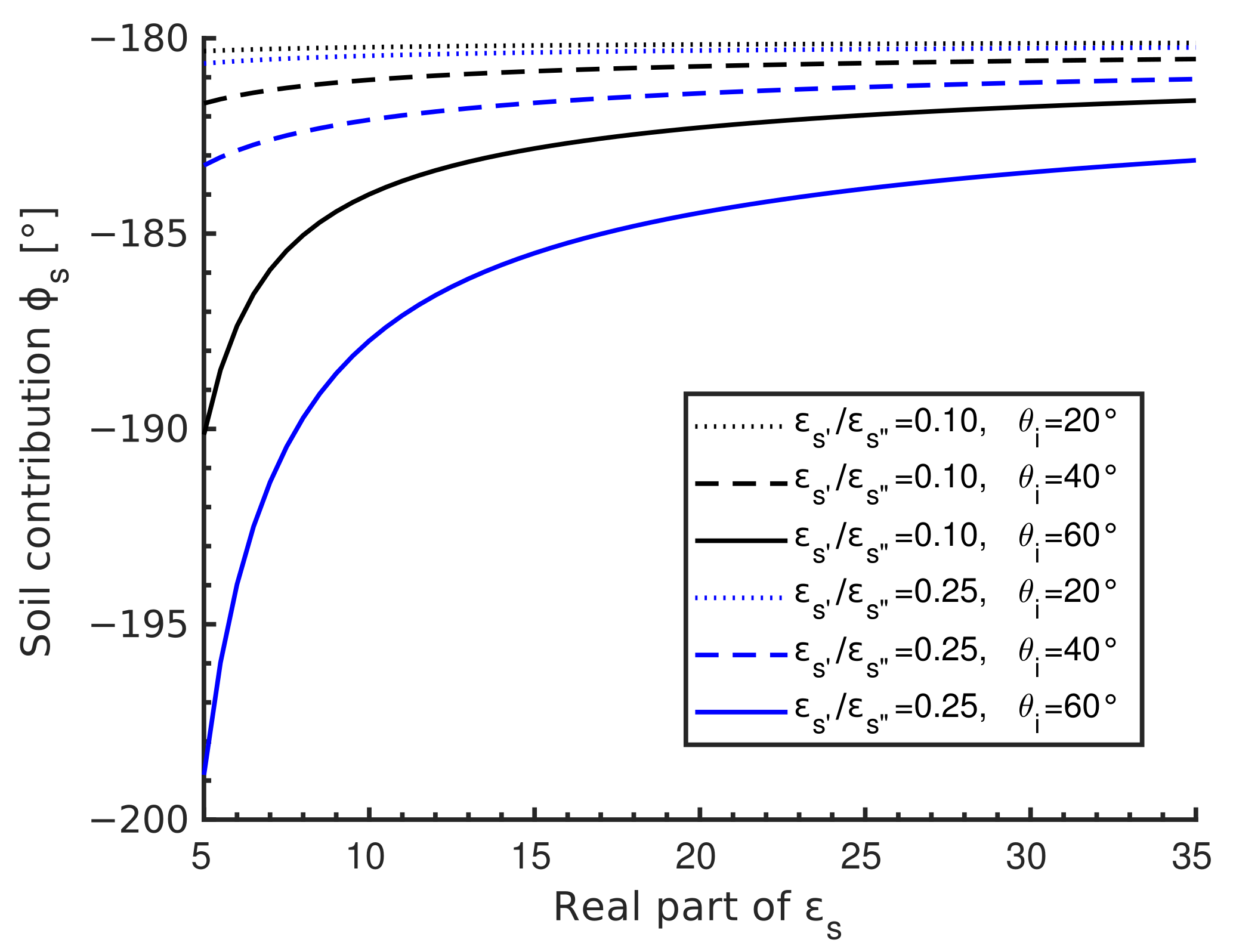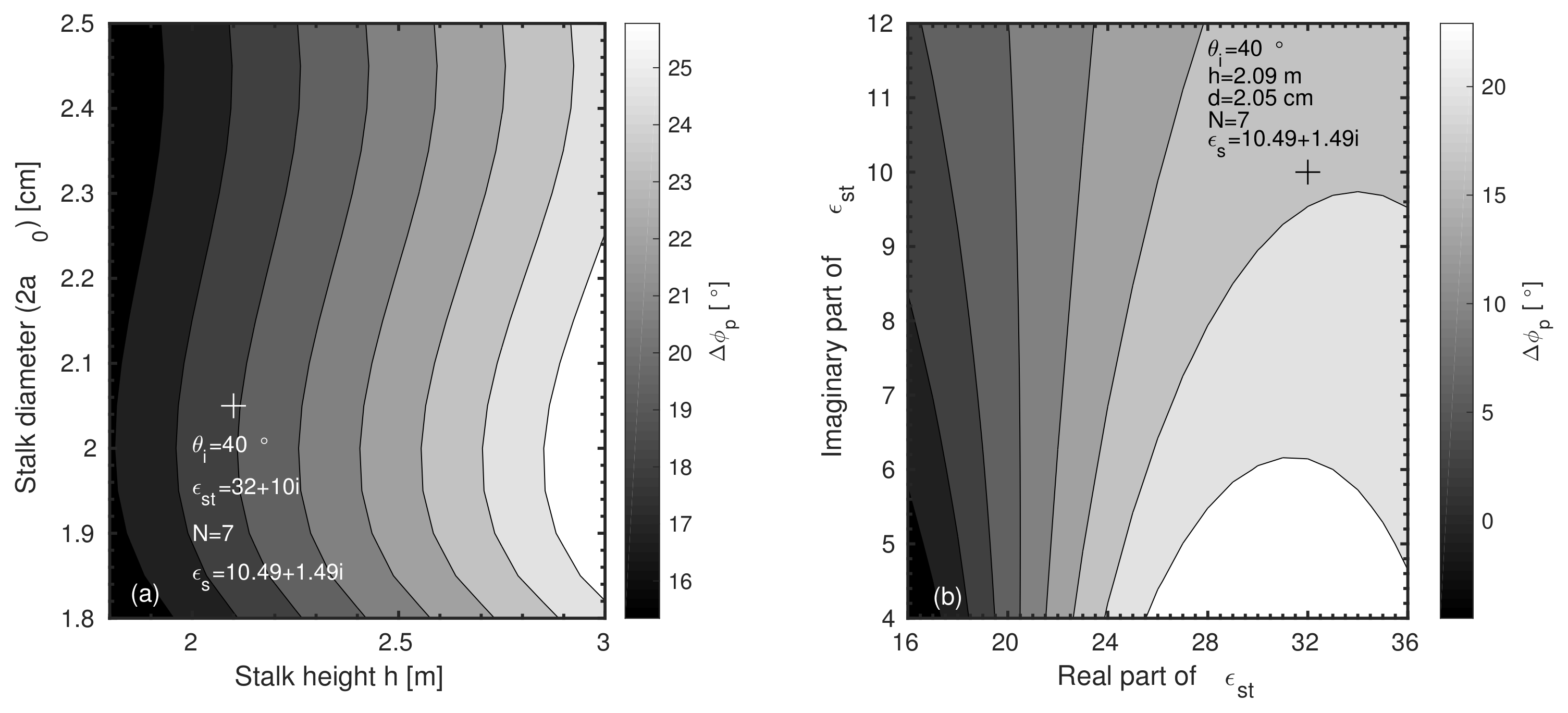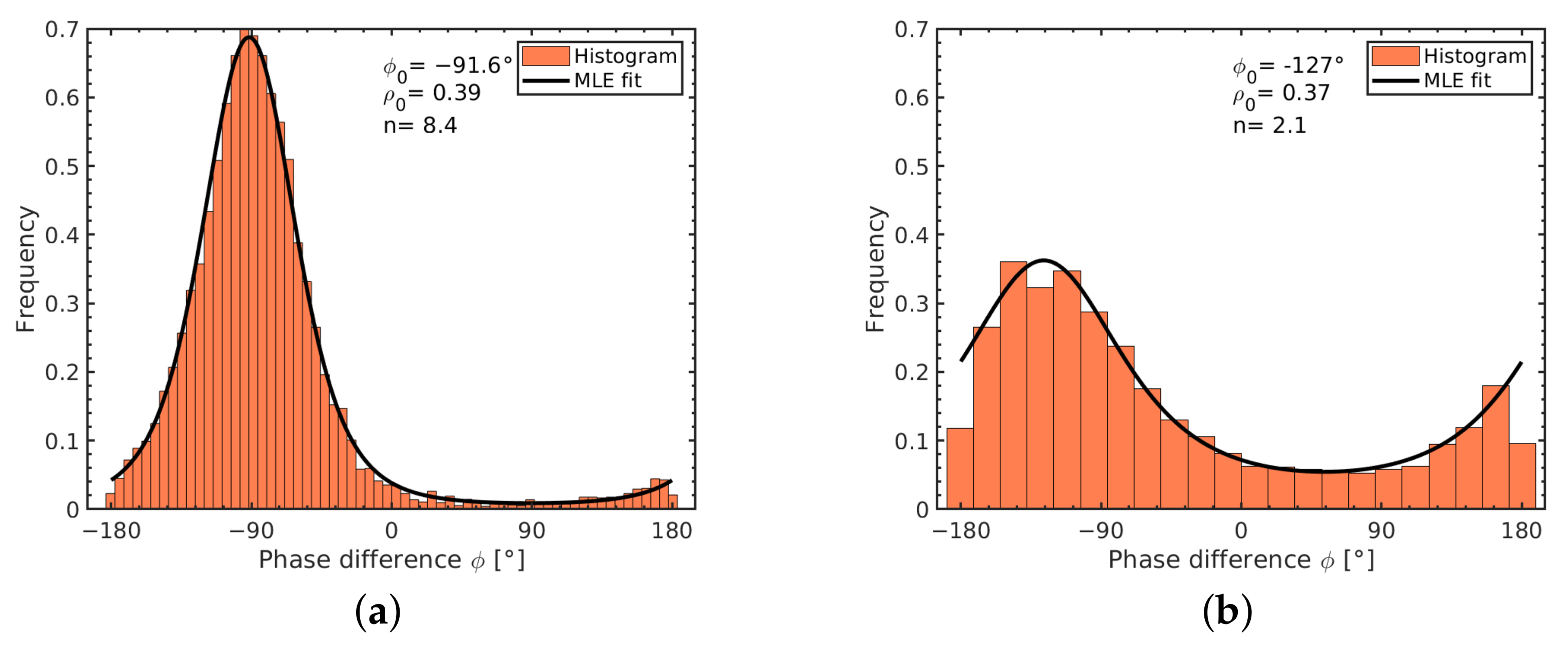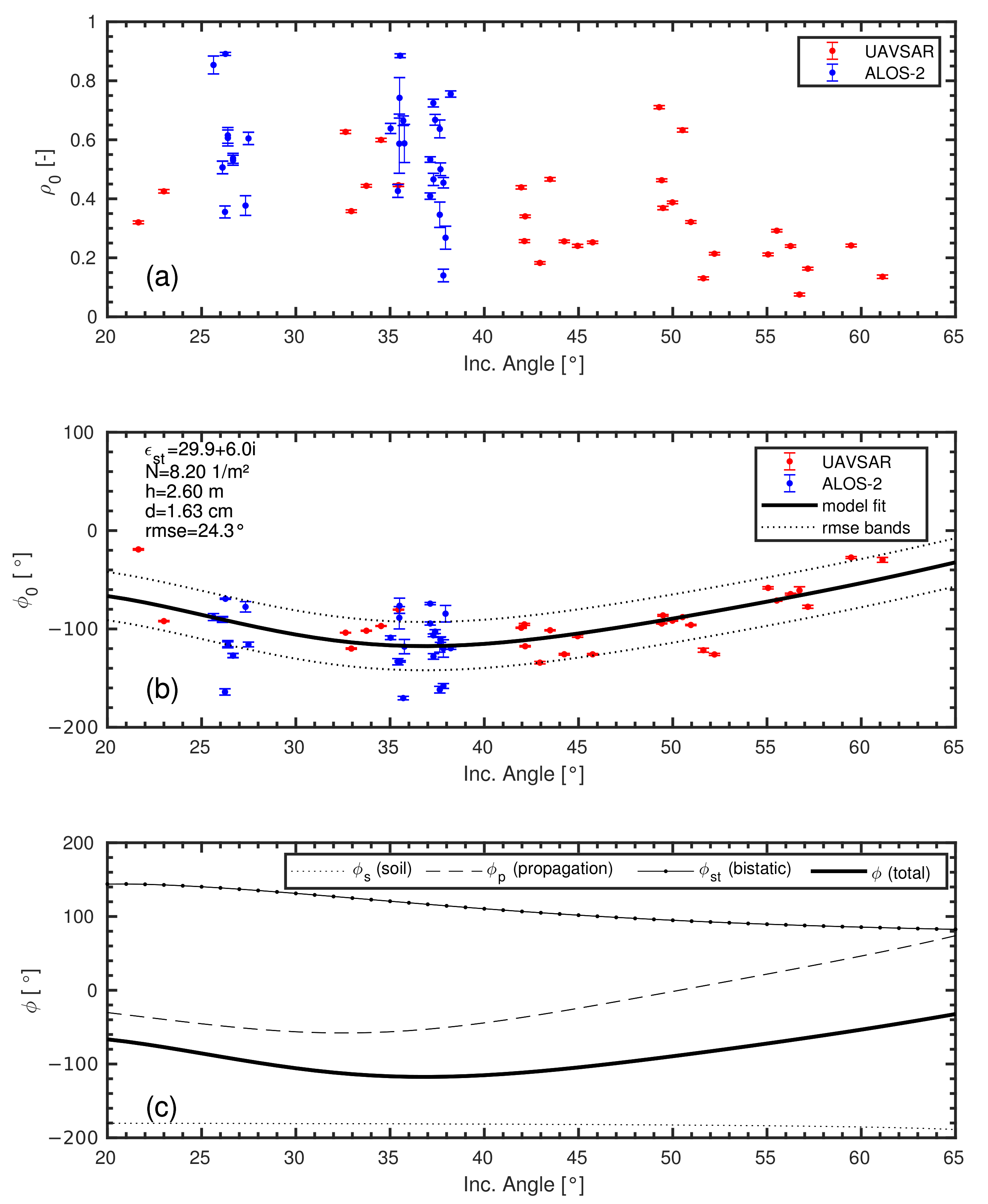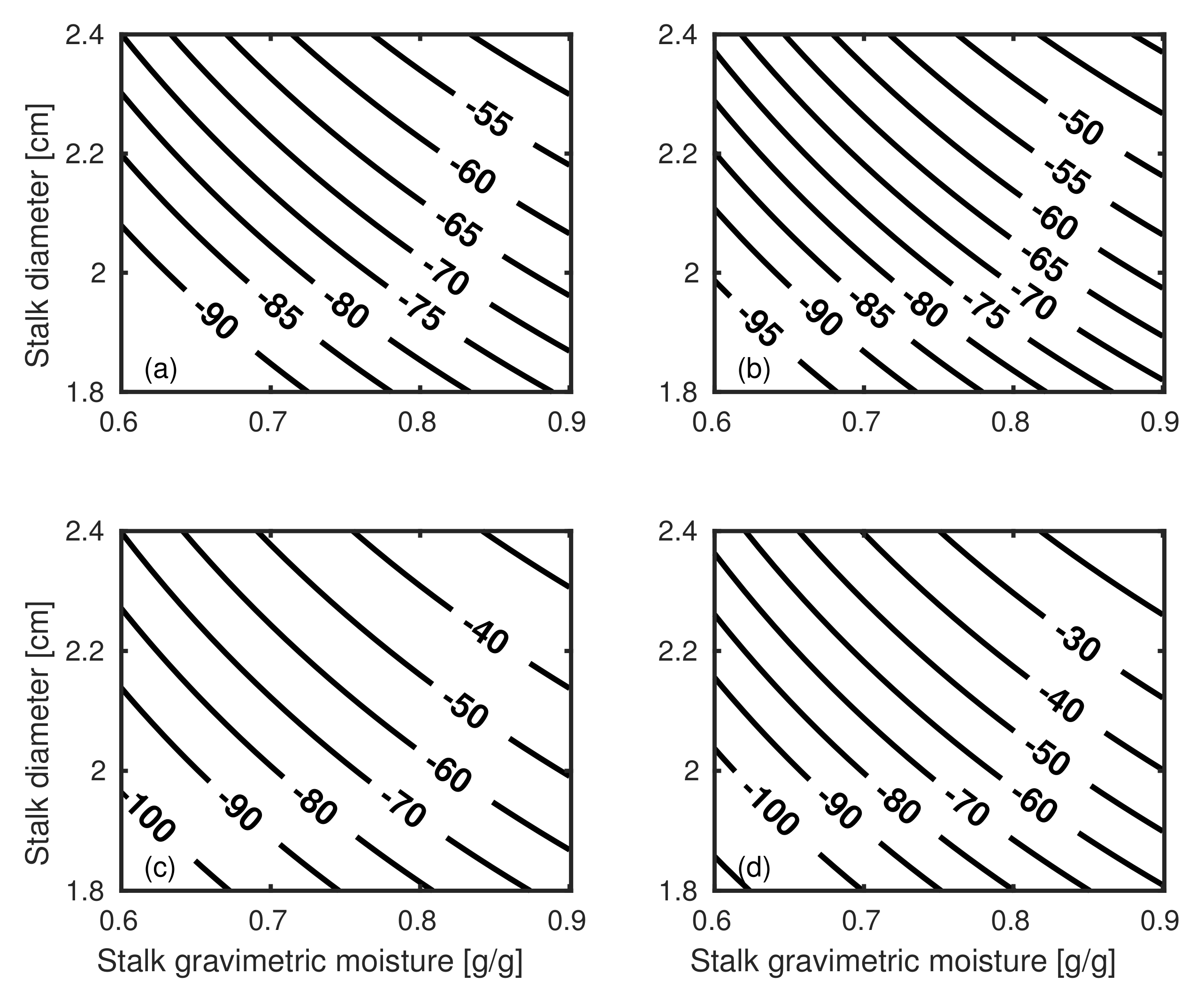1. Introduction
The potential of active microwaves to monitor agricultural areas is recognized as a key feature for supporting application-oriented approaches such as crop classification schemes (e.g., [
1,
2,
3]), crop height estimation (e.g., [
4,
5,
6]), soil moisture estimation (e.g., [
7,
8]), among others, and to aid decision-makers in managing and assessing agricultural resources. Towards this goal, the NASA/JPL’s UAVSAR airborne L-band mission was deployed to support several soil moisture and vegetation features inversion strategies [
9,
10,
11]. In this respect, the systematic use of polarimetric SAR data from orbiting sensors at L-band over croplands was almost limited to JAXA’s Advanced Land Observing Satellite 2 (ALOS-2) Phased Array type L-band Synthetic Aperture Radar (PALSAR-2) mission (global.jaxa.jp/projects/sat/alos2) over the years. However, this situation has recently improved with the successful launch of the Argentinean L-band SAR constellation mission SAOCOM-1A and 1B (
saocom.invap.com.ar) on 7 October 2018, and 30 August 2020, respectively. Both sensors have a lifespan of 5.5 years and were designed with interferometric and polarimetric capabilities. Within its goals, the SAOCOM constellation will provide fully polarimetric acquisitions dedicated to monitoring large cropland areas in Argentina, representing an important contribution to agriculture and hydrology worldwide.
The NASA-ISRO Synthetic Aperture Radar (NISAR) mission, which is planned to be launched in 2023, will provide L- and S-band full-polarized data over vegetated terrain, adding up its polarimetric capabilities to existing imagery [
12]. In addition, the European Space Agency has recently signed the contract to develop the new high-priority Copernicus Radar Observation System for Europe in L-band (ROSE-L) as part of Europe’s Copernicus program. With a launch planned in 2028, this system will present polarimetric capabilities and its main product types and formats will be aligned as much as possible with the ones of Sentinel-1, for enhanced continuity [
13].
Among major crops, corn is the most cultivated cereal worldwide according to the latest Food and Agriculture Organization (FAO) data [
14], with a total production of 1149 Mt in 2019, followed by wheat (765.8 Mt), paddy rice (755.5 Mt), soybeans (333.7 Mt), and barley (159.0 Mt) in the same year. Following the significant SAR missions mentioned, amplitude and phase measurements will be systematically delivered to cover most of these major crops, among which corn fields have unique features: corn plants have the largest dimensions with stalk heights up to 3
, stalk diameters up to 2.5
and large moisture contents up to 0.90
[
11,
15,
16]. Furthermore, corn seeds are usually planted in a regular pattern of 7 to 9 plants per square meter onto rows separated 75
apart [
11,
16,
17]. This pattern and the unique plant features, often in the resonant regime for wavelengths at the L-band, make the interaction of electromagnetic waves with corn fields very complex to model.
Efforts in this direction were made on computing the scattering of a collection of randomly distributed vertical cylinders, thus modeling the plant stalks over a dielectric half-space. Smaller plant elements such as leaves and cobs were usually disregarded. High order solutions involving multiple interactions among the cylinders and the underlying dielectric half-space were obtained by Monte Carlo simulation or by radiative transfer theory ([
18,
19]). However, for an application-oriented approach, a Monte Carlo simulation is of limited practical use because of the ensemble-based statistical nature of its solution. In the radiative transfer approach, solutions for modeling large dielectric structures such as corn stalks should deal with an overestimation of phase and extinction matrices [
18].
A more straightforward approach that incorporates much of the interaction complexity with few input parameters is the model developed by Ulaby et al. [
17]. This model relied on previous experimental measurements to treat a corn canopy as a low-loss medium, thus allowing for a description in terms of an equivalent dielectric medium characterized by a complex index of refraction. With the noticeably uneven distribution of volumetric moisture content between leaves and stalks during much of the growth stages, the contribution of the plant leaves to total scattering can be disregarded for longer wavelengths, such as in L-band.
Ulaby’s model was experimentally validated in [
17] using an image-based relative phase calibration, where near-range azimuth rows were assumed to have a co-polarized phase difference near zero, and thus converting relative values to absolute values in the remaining image. An ad hoc 180° phase shift added to the model ([
17], Equation (
5)) should be disregarded on properly absolute calibrated images such as that of the aforementioned SAR missions. The dataset used in Ulaby’s research for validation involved relatively mature, dried vegetation with low stalk volumetric moisture [
17]. No validation is reported for other conditions, nor was further research in this respect found elsewhere. Moreover, research on L-band co-polarized phase differences on crops is scarce (e.g., [
20]). Most of the research using polarimetric SAR data relied on higher frequencies (C- and X-band) [
21,
22,
23] or multi-polarization intensity-only studies [
24]. These shortcomings will be addressed in this manuscript, which turns out to be a novel contribution of this work.
When corn plants reach their peak biomass, vegetation water content is near maximum, and canopy attenuation and stalk’s coherent effects are significant. The empirical fitting used in [
17] to compute the dielectric constants of stalks from their gravimetric water content was limited by its upper bound ([
25], Chapter 4–9.2). For larger water contents, the model developed by Mätzler in [
26] will be considered.
In this research, a validation of Ulaby’s incoherent multi-parameter model with experimental data on grown corn fields is shown. Mätzler’s model for a bulk dielectric constant is coupled with Ulaby’s model to account for the large water content found in the stalks of grown corn plants and to avoid time-consuming, laboratory-based dielectric constant measurements. Two datasets were used, (1) fields in Canada imaged by the airborne sensor UAVSAR and (2) fields in Argentina imaged by the satellite-borne ALOS-2/PALSAR-2 sensor. Good agreement is made, which enables us to consider this model for retrieving purposes through inverse modeling techniques.
The outline of this paper is given as follows:
Section 2 states a brief review of Ulaby’s fitting model, a sensitivity assessment of its model parameters with stalk features, and a description of Mätzler’s model to estimate stalk dielectric constant from gravimetric measurements. Then, details of data used in this paper are introduced, including SAR data quality and the method for estimating co-polarized phase differences. The SAR data statistics and the fitting of the Ulaby–Mätzler’s model to remotely-sensed co-polarized phase differences are analyzed in
Section 3. This coupled model and its implications for corn parameter retrieval are discussed in
Section 4. Concluding remarks are stated in
Section 5.
2. Materials and Methods
2.1. Incoherent Multi-Parameter Fitting Model
The co-polarized phase difference
is defined as the difference in the absolute phase between the linearly polarized HH and VV complex scattering amplitudes
In lossy media,
accounts for many scattering mechanisms and contributions. On a grown corn canopy,
is modeled as a result of the sum of three single contributions
where
accounts for the phase term due to wave propagation through the canopy,
for the forward scattering by the soil surface followed by bistatic scattering by the stalks, or the reverse process, and
for the specular reflection on the soil. Each one of these scattering mechanisms was evaluated following Ulaby’s model [
17] and compared to SAR data.
Ulaby’s model [
17] to be fitted accounts for the scattering interaction between the plant stalk and an underlying rough, moistened surface to compute (2). Corn plants were modeled as vertical dielectric cylinders, long enough relative to the wavelength to rely on the infinity cylinder scattering solution, which is given in the form of a series [
27]
where
is the normalized far-field scattering amplitude, the subscript states the polarization of the impinging wave onto a linear basis (H or V),
is the incidence angle relative to the plane containing the cylinder’s axis, and
is the azimuth scattered angle. The dependence of the functions
on the wavenumber
k of the impinging wave, the radius
and the complex dielectric constant
of the cylinder is cumbersome and the reader is referred to [
27] for their analytical expressions.
The solution given by (3) is applied two-fold. Firstly, Ulaby et al. [
17] have shown that propagation in a layer comprising identical vertical cylinders randomly positioned on the ground may be modeled in terms of an equivalent dielectric medium characterized by a polarization-dependent complex index of refraction. The model assumed stalks are arranged with
N cylinder per unit area and are far away enough such that multiple scattering is negligible. Hence, the phase constant of the index of refraction is used to compute the co-polarized phase difference for two-way propagation (
in (3)). Secondly, the scattering solution in (3) is used to compute the phase difference between waves bistatically reflected by the stalks by considering specular scattering only (
in (3)).
The first term on the right side in (2) computes the phase term due to the two-way, slanted propagation through the canopy,
where
h is stalk height. In (4), the scattering features of the stalks are accounted for in the
amplitudes, where canopy bulk features are accounted for in the stalk density
N and in
h. The scattered angle is evaluated at the forward direction (
) [
27].
The second term in (2) accounts for the phase term resulting from forward scattering by the soil surface followed by bistatic scattering by the stalks, or the reverse process,
where the solution should be sought in the domain
. Here,
accounted for the specular direction.
The third term in (2) is the contribution from specular reflection on the soil through Fresnel reflection coefficients
and
[
25]
where
is the complex dielectric constant of the soil surface underlying the canopy. The contribution of this term is about −180° due to the small imaginary part of
in typical soils and the difference in sign between
and
. Because of this term, total co-polarized phase difference
, over grown corn canopies yields negative values on absolute calibrated polarimetric images.
2.2. Sensitivity Analysis of the Model Parameters
The three phase terms defined from (4) to (6) account respectively for the phase difference by propagation through the stalks, by the bistatic reflection, and by the soil. Each of these terms has different contributions to the total co-polarized phase difference in (2). In what follows, a sensitivity analysis will be carried out, where frequency will be fixed at an intermediate 1.25 , that is, between those of UAVSAR and ALOS-2/PALSAR-2.
Among the three terms, the soil term
has a simple dependency on the soil’s complex dielectric constant
. A typical imaginary-to-real ratio of
is 0.10, and commonly used empirical models predict this ratio to be as large as 0.25 [
28,
29,
30]. Then, it follows from
Figure 1 that the
dynamic range is less than 16° for an imaginary-to-real ratio of 0.10 (black lines) and 0.25 (blue lines). Three incidence angles 20°, 40°, and 60° are evaluated. Then, for a typical observation geometry at 40° incidence angle, the sensitivity to the dielectric constant shown by
is of little relevance to the total phase difference.
The propagation term in (4) has a linear dependence with the stalk density
N and with the stalk height
h. Moreover, since they are of the same order of magnitude, the effect of varying
N or
h on
will be equivalent. Conversely, the
and
are nonlinear model parameters through
and the following sensitivity analysis will be focused on them. First, contour levels depicting the dependence of
on
and
h at
are shown in
Figure 2a. The contours are variations of
computed as
where it is understood that the other three terms involving derivatives (on
,
, and
N) were computed and evaluated from the mean values collected on the ground, and these are indicated in the inset in
Figure 2a.
A significant gradient indicated a high sensitivity to stalk height. This related to the linear term
h in (4). Conversely, a small sensitivity on
is related to a cancellation effect due to the difference operator in (4), since both
and
depend on
. The model exhibits
when evaluated at the ground measurements (white ‘+’-mark in
Figure 2a). For a better comparison to ground measurements, stalk diameter
instead of stalk radius
is shown. Since
N and
h are of the same order, contours for
varying
N instead of
h will result in sensitivities similar, slightly smaller though, to the ones depicted in
Figure 2a.
The sensitivity analysis on
for the real
and imaginary
parts of
is shown in
Figure 2b, where the inset indicates the parameters the model is evaluated at. Here, the contours range from around 0° to 20°, accounting for a larger sensitivity on
in relation to that on
h. However,
when evaluated at the ground measurements, similar to the sensitivity found in
Figure 2a.
The bistatic term does not depend on h nor N. Moreover, overall the variation of on ranges from −7° to −2° with about −5° of variation with the model evaluated at the ground measurements. Hence, the contribution of the bistatic term to the overall model sensitivity is negligible. Similar results are reached for the sensitivity of on and .
The aforementioned analysis for and considered a fixed incidence angle . Computing the contour levels at different angles showed that:
At , the variations evaluated at the ground measurements are on the -space and on -space;
Similarly, at resulted in and ;
At both and , is bounded between −6° and −3°.
From these remarks, it turns out that sensitivity improved with increasing incidence angles for , whereas the contribution to the overall sensitivity of the term is negligible.
2.3. Microwave Dielectric Constant of Stalk from Gravimetric Measurements
The propagation and bistatic terms in (4) and (5) depend on stalk diameter and dielectric constant through the far-field solution in (3). Whereas the collection of
is straightforward from the ground,
requires tuned laboratory measurement techniques [
31]. From a large set of dedicated measurements, semi-empirical models relating bulk vegetation dielectric properties with vegetation moisture were developed by Ulaby and El Rayes [
32], and Mätzer [
26]. These are shown in
Figure 3 for the vegetation moisture within the stalks. Concerning the range of validity, a slight drawback in Ulaby and El Rayes’ model is the upper bound of vegetation moisture used to fit the data. In effect, the model was fitted for gravimetric moisture
in the range 0.0–0.7 g/g ([
25], Chapter 4-9.2). On the other hand, Mätzer’s model [
26] comprised measurements with larger moisture contents, which allowed setting an empirical fitting with
in the range 0.5–0.9 g/g. Since typical gravimetric moisture for growth corn stalks is larger than 0.6 g/g, Mätzler’s model is better suited and will be used here to estimate the dielectric constant of vegetation material within corn stalks. Its input parameters are gravimetric moisture of plant stalks and frequency of the impinging wave. In
Figure 3, note the trend in Ulaby and El Rayes’ model of larger dielectric values with respect to those in Mätzer’s model.
2.4. Study Area and Ground Data Collection
The dataset to fit the Ulaby’s incoherent multi-parameter model was taken from the Soil Moisture Active Passive Validation Experiment 2012 (SMAPVEx12) over southwest of Winnipeg, Manitoba, Canada, centered on the town of Elm Creek (98°0′23″ W, 49°40′48″ N) [
11,
33] and from intensive campaigns led by the SAOCOM mission’s science team near the town Monte Buey (32°55′11″ W, 62°27′22″ S), located in central Argentina over Pampas Plain. With these datasets, co-polarized phase measurements on grown corn fields covered incidence angles roughly from 20° to 60°.
In Canada, eight corn fields were imaged by UAVSAR at peak biomass on 17 July 2012. Each acquisition of the UAVSAR comprised four main flight lines with different incidence angles totaling 32 data points. Vegetation was characterized within a one-day window from the flight day: stalk height and diameter were measured. The former was measured with a meter tape and the latter with a caliper over 10 plants within the field selected at random positions. Then, the 10-plant average is computed. Stalk gravimetric moisture was also measured on a less frequent basis, though, due to time-consuming laboratory procedures. Five plants along two rows (ten in total) were collected, bagged appropriately, and then weighted before and after the samples were placed in drying facilities to quantify their water content [
11]. A summary of the stalk features for the eight fields in Canada is shown in
Table 1.
In Argentina, CONAE has the largest instrumented site over croplands dedicated to calibrating the soil moisture retrieval algorithm for the SAOCOM 1A and 1B mission. In March, April, and June 2017, intensive campaigns over a 140 × 100 km region were conducted and basic ground information over 20 corn fields among other crop types was gathered. Ground information included 0–5-cm soil moisture, stalk height, and till status. Stalk height measurements were taken at convenient positions while the plant was standing in the field. Measurements involving the removal of the plant were disregarded due to time-constraints. The stalk height is summarized in
Table 1. These fields were imaged by ALOS-2/PALSAR-2 on several dates totaling 30 data points.
2.5. SAR Data and Its Quality and Processing Chain
Airborne UAVSAR provided full-polarimetric imagery over Canada with local incidence angles ranging from 20° to 60°. It measured complex scattering coefficients at a frequency of 1.258 GHz. Co-polarized phase measurements are given with a root mean squared phase error ∼
and always smaller than
[
34]. The pixel size on the ground projected image is 5.0 × 7.2
onto a swath of 20
.
As read from its metadata, UAVSAR imagery has the coherence matrix as a native image format where is readily extracted from. Multi-looked (12 pixels in azimuth by 3 pixels in range) and ground range projected data were used. The ground projection method was nearest neighbor. With the -images, local incidence angle bands were also provided.
Concurrent with the ground measurements over Argentina, fully polarimetric images were acquired by satellite-borne ALOS-2/PALSAR-2 sensor at 1.236 GHz in High-sensitive Full Polarimetry mode with a 50-km swath width at two incidence angle ranges: 25–30° and 30–35°. This sensor delivered co-polarized phase difference measurements with an imbalance better than
° ([
35], Table 3).
For ALOS-2/PALSAR-2, the processing chain started with radiometric calibration from Single Look Complex (SLC) scenes. Subsequently, multilooking was applied (4 pixels in azimuth by 2 pixels in range) to obtain an approximate square pixel and improve the images’ radiometric quality. Coherence matrices were computed and then geocoded to a 12 × 12 m ground pixel size using bilinear resampling. As the final product, output bands for complex scattering product and for local incidence angle were generated.
2.6. Polarimetric Observable
With the above-mentioned phase-calibrated images, the derivation of the absolute co-polarized phase difference defined in (1) is given by
where
and
are the co-polarized complex scattering amplitudes, and
denotes a complex conjugate. In (8),
is defined in the range
. The statistical distribution of
for a speckled image is known, and its closed-form expression is [
36]
with
where
is a Gauss hypergeometric function. In (9),
is the correlation between
and
, also known as coherence,
is the phase difference of the sample,
is the gamma function, and
n is the equivalent number of looks, which is estimated by means of a matrix-variate estimator based on the trace of the product of the covariance matrix
C with itself (
), thus using all polarimetric information [
37].
4. Discussion
Availability of a fully polarimetric dataset involving airborne and satellite-borne images and stalk dielectric, structural, and spatial parameters enabled a multi-parameter modeling over corn fields. The model considered here for the co-polarized phase difference comprised three incoherent contributions with different sensitivities. Whereas the soil term set an almost constant reference level of around -180°, propagation and bistatic terms had a marked dependency with height, diameter, and moisture of the stalks. By adding them up, the incoherent, interaction-based model fitting showed good agreement with UAVSAR and ALOS-2/PALSAR-2 acquisitions, provided the dispersion in the ground measurements be accounted for. By separating each of the contributions, a more accurate understanding of crop interaction is made, advancing previous research where a full explanation of observation data could not be given since considerable modeling efforts were required [
20,
24]. Moreover, a number of dedicated radar experiments [
15,
16,
40] with detailed field measurements collected on corn fields can benefit from incorporating a co-polarized phase model to extend their findings to phase-related observables, since modeling efforts associated with these experiments were limited to intensity-related observables only.
More accurate crop scattering models will likely include detailed canopy physical attributes, other than only stalk height and width, such as leaf area index, leaf orientation distribution, and leaf size [
41], among others. As a result, a direct relationship of the scattering with plant biophysical parameters might not be easy to develop. On the other hand, scattering models with interaction at higher orders for randomly distributed vertical cylinders rely on Monte Carlo simulations or iterative methods [
18]. Thus, the few parameters implied in the Ulaby’s model and its straightforward analytical expression highlight its usefulness.
From the sensitivity analysis on Ulaby’s model described in
Section 2.2, the stalk height resulted in the highest sensitivity on the propagation term
for all the incidence angles. This goes in line with the application mentioned at the end of
Section 3, where the contours shown in
Figure 6 leverage the stalk height retrieval from other remotely-sensed techniques (i.e., [
21]) through the improved sensitivity of the term
in the total
. In this regard, corn height estimates with a root mean square error around 40–50 cm over a growing season were demonstrated with machine learning techniques over a dataset of polarimetric SAR observables at the C-band [
21]. This study also highlighted the relevance of polarimetric features related to double-bounce scattering (i.e.,
) [
21]. Moreover, model parameterization by stalk gravimetric moisture content instead of its complex dielectric constant using Mätzler’s model demonstrated a potential resource for dimensionality reduction, thus helping future application-oriented developments.
Several techniques are usually validated with data from airborne campaigns and then expected to be readily applied with similar levels of accuracy to imagery acquired by orbiting sensors. In the case analyzed in this research, field-based estimates from satellite-borne acquisitions such as those of ALOS-2/PALSAR-2 were clearly constrained by histograms with fewer data points since the larger pixel sizes involved were compared to airborne acquisitions. With the sound histogram-based, matrix-variate Maximum Likelihood Estimation technique described in
Section 3.1, the estimates from ALOS-2/PALSAR-2 resulted in slightly larger, otherwise reasonably bounded, uncertainties than UAVSAR ones.
With the increasing availability of L-band space-borne SAR missions adding to existing C-band SAR resources (e.g., European Space Agency’s Sentinel-1), multi-frequency methodologies may become fully operational in the near future. The multi-frequency approach exploits different penetration capabilities into the vegetation canopy. For instance, these enhanced capabilities can potentially circumvent typical issues regarding the classification of crops with similar architectures such as corn and sorghum, the latter widely spread in America and Africa. To a greater extent, if multi-frequency polarimetric SAR data become available, polarimetric modeling such as the Ulaby–Mätzler model can enhance further corn plant parameter retrieval.
